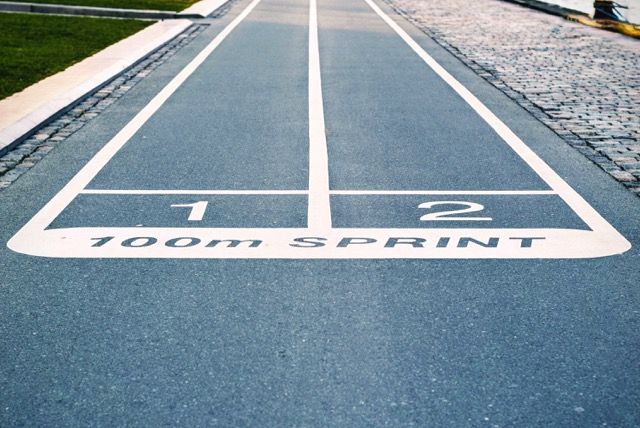Hybrid Athletes Unite: How to Crush Your First Marathon with Smart Training
Balancing Strength and Endurance Training for Your First Marathon
Table of contents
- Benefits of Marathon Running for Hybrid Athletes
- Assessing Your Current Fitness Level
- Setting Realistic Goals
- Creating a Marathon Training Plan
- Building Endurance: Long Runs and Tempo Runs
- Strength Training for Marathon Running
- Cross-Training for Marathon Running
- Fueling Your Body for Marathon Training and Race Day
- Hydration Strategies for Marathon Running
- Mental Toughness: Tips for Staying Focused and Motivated
- Race Day Strategies: What to Expect and How to Prepare
- Common Injuries and How to Prevent Them
- Recovery Strategies: Rest, Nutrition, and Active Recovery
- Whew! That was A LOT!
- FAQs
If you're a hybrid athlete looking to tackle your first marathon, you may feel intimidated by the prospect of running 26.2 miles. But with smart training, you can crush your first marathon and achieve your goals. In this article, we'll provide you with a comprehensive guide on how to train for your first marathon, including tips for building endurance, strength, and mental toughness.
Explore some of the sponsors of this blog and discover cool apps, products, or websites that I'm currently using and loving by visiting the links below 👇
Do Hard Things*: Achieve fitness goals with Fit for Life, a minimalist log book for men and women. Track progress and set monthly goals with expert design.
LMNT: Stay Salty! A tasty electrolyte drink mix that is formulated to help anyone with their electrolyte needs and is perfectly suited to folks fasting or following low-carb, whole-food diets
Hypefury: Schedule & Automate Social Media Marketing Your personal assistant to grow & monetize your Twitter audience
Fancy Hands: My VA of choice! I’m pretty excited to hand off some of my work. Thought you’d be interested too. As a bonus, you'll get 50% off your first month
yourcompany.com*: Interested in sponsoring this blog? 📩 → [blogSponsor@hybridathletepro.com*](mailto:blogSponsor@hybridathletepro.com)

Benefits of Marathon Running for Hybrid Athletes
As a hybrid athlete, you may already engage in a variety of physical activities, such as weightlifting, cycling, or swimming. Marathon running can be a great addition to your fitness routine, offering a unique set of benefits. Running a marathon can help you:
Build cardiovascular endurance
Increase overall fitness and strength
Improve mental toughness and resilience
Boost self-confidence and self-esteem
Connect with a community of like-minded athletes

Assessing Your Current Fitness Level
Before embarking on a marathon training plan, it's important to assess your current fitness level. This will help you set realistic goals and tailor your training plan to your individual needs.
Your current running mileage and pace
Assessing your current running mileage and pace is crucial when preparing for a marathon. This information will help you determine where you stand in terms of endurance and fitness level. If you haven't been running consistently, you'll need to start slowly and gradually increase your mileage over time.
It's also important to evaluate your pace. Your pace will affect your training plan and the time it takes to complete a marathon. Knowing your current pace will help you set realistic goals and determine how much training you need.
To assess your running mileage and pace, you can use a running app or GPS watch to track your runs. Alternatively, you can use a running calculator to estimate your pace based on your previous runs. Once you know your current mileage and pace, you can adjust your training plan accordingly.
If you're new to running or unsure about your current level of fitness, it may be helpful to consult with a running coach or trainer. They can help you evaluate your fitness level and create a personalized training plan that meets your specific needs and goals.
Your overall fitness level and any strengths or weaknesses
Assessing your overall fitness level and identifying your strengths and weaknesses is an essential part of marathon training. Understanding your fitness level will help you determine the areas that need the most improvement and where to focus your training efforts.
Assessing your overall fitness level can be done through various methods such as body composition analysis, VO2 max testing, and functional movement assessments. It's important to consider both your cardiovascular and muscular fitness when evaluating your overall fitness level.
Identifying your strengths and weaknesses can be done through a combination of self-reflection and professional evaluation. For instance, if you're naturally strong but struggle with endurance, you may need to focus on building cardiovascular fitness. If you struggle with maintaining proper form or have a previous injury, working with a physical therapist or coach can help you address these issues and prevent further injury.
Once you have identified your strengths and weaknesses, you can tailor your training plan to address them. This may involve incorporating specific exercises or activities to improve your weak areas and increase your overall fitness level.
It's important to remember that everyone has strengths and weaknesses, and that focusing on both can lead to a more balanced and successful training experience. By assessing your overall fitness level and identifying your strengths and weaknesses, you can create a personalized training plan that addresses your specific needs and goals.
Any pre-existing injuries or health conditions
Assessing any pre-existing injuries or health conditions is crucial when preparing for a marathon. Ignoring these issues can lead to further injury and prolong recovery time. Before starting any training program, it's important to consult with a healthcare provider to determine if you're healthy enough to participate in marathon training.
If you have any pre-existing injuries or health conditions, it's important to address them before beginning training. This may involve working with a physical therapist or other healthcare provider to develop a rehabilitation plan. It's also important to incorporate injury prevention strategies into your training plans, such as proper form and cross-training.
When training for a marathon with a pre-existing injury or health condition, it's important to be cautious and listen to your body. This may involve adjusting your training plan, taking rest days when needed, and seeking medical attention if necessary.
If you have a chronic health condition, such as asthma or diabetes, it's important to work with your healthcare provider to manage your condition during training and on race day. This may involve adjusting medication or incorporating specific dietary strategies to ensure optimal health and performance.
Your available time and resources for training
Assessing your available time and resources for training is a crucial part of marathon preparation. Marathon training requires a significant time commitment, and it's important to ensure that you have enough time to complete the necessary workouts and recovery periods.
When assessing your available time, it's important to consider other commitments such as work, family, and social activities. Creating a schedule or calendar can help you plan your training around these commitments and ensure that you have enough time for both training and rest.
In addition to time, it's important to consider your available resources for training. This may include access to a gym or fitness equipment, a running group or coach, and appropriate gear and attire for running. If you don't have access to these resources, there are many online resources and virtual training programs that can be used to prepare for a marathon.
When creating a training plan, it's important to be realistic and take into account your available time and resources. This may involve adjusting your training plan to fit your schedule or finding alternative workouts that can be done at home or on the go.

Setting Realistic Goals
Once you've assessed your current fitness level, it's time to set realistic goals for your marathon training. Your goals should be specific, measurable, attainable, relevant, and time-bound (SMART). You may want to consider:
Your desired finish time for the marathon
Setting a desired finish time for the marathon is an important part of marathon preparation. This goal can provide motivation and help you stay focused during training. However, it's important to set a realistic goal based on your current fitness level and training progress.
To set a desired finish time, it's important to consider your current pace, overall fitness level, and previous race times. If you're new to running or have never completed a marathon before, it may be helpful to set a goal based on simply finishing the race rather than a specific time.
When setting a finish time goal, it's important to remember that finishing a marathon is a significant accomplishment in itself. It's also important to consider other factors that may affect your finish time, such as weather conditions, course difficulty, and injury or illness.
Once you've set a desired finish time goal, it's important to incorporate appropriate training strategies to help you reach that goal. This may involve incorporating speedwork, long runs, and recovery periods into your training plan. Working with a running coach or joining a running group can also provide guidance and motivation during training.
Your goal for the amount of training you will complete
Setting a goal for the amount of training you will complete is an important part of marathon preparation. This goal can help you stay on track and ensure that you are adequately prepared for the race.
When setting a training goal, it's important to consider your overall fitness level, available time and resources, and desired finish time. This goal should be realistic and take into account other commitments such as work and family.
A typical marathon training plan lasts between 12-20 weeks, with 4-6 training days per week. It's important to gradually increase mileage and intensity over time to prevent injury and ensure that your body is adequately prepared for the demands of the race.
When setting a training goal, it's important to be flexible and adjust your plan as needed. This may involve taking rest days when necessary or incorporating additional cross-training or recovery periods. It's also important to listen to your body and be cautious of overtraining, which can lead to injury and burnout.
Working with a running coach or joining a running group can also provide guidance and support during training. These resources can help you develop a personalized training plan that meets your specific needs and goals.
This goal should be realistic and take into account other commitments and available resources. By gradually increasing mileage and intensity over time and incorporating appropriate recovery periods, you can safely and successfully prepare for a marathon.
Any secondary goals, such as weight loss or improved mental toughness
In addition to setting a goal for the amount of training you will complete and a desired finish time for the marathon, it's important to consider any secondary goals you may have. These goals can provide additional motivation and help you stay focused during training.
Secondary goals may include weight loss, improved mental toughness, or increasing overall fitness and strength. It's important to set realistic goals that align with your primary goal of completing the marathon.
If weight loss is a secondary goal, it's important to create a nutrition plan that supports your training while also promoting weight loss. This may involve incorporating more whole foods and reducing calorie-dense, processed foods.
Improving mental toughness is another common secondary goal. This can be achieved through incorporating mental training strategies into your training plan, such as visualization, positive self-talk, and setting mini goals throughout the race.
Increasing overall fitness and strength can also be a secondary goal. This may involve incorporating strength training exercises into your training plan, such as weightlifting or bodyweight exercises, to improve muscular endurance and prevent injury.
When setting secondary goals, it's important to prioritize your primary goal of completing the marathon. Setting too many goals can be overwhelming and lead to burnout. It's also important to adjust your goals as needed based on your progress and any challenges that may arise during training.

Creating a Marathon Training Plan
With your goals in mind, it's time to create a marathon training plan. Your plan should include a mix of running, strength training, cross-training, and rest days.
The length of your training plan (typically 12-20 weeks)
The length of your training plan is an important factor to consider when preparing for a marathon. A typical marathon training plan lasts between 12-20 weeks, with 4-6 training days per week.
The length of your training plan may vary based on your current fitness level, previous running experience, and the desired finish time for the marathon. It's important to gradually increase mileage and intensity over time to prevent injury and ensure that your body is adequately prepared for the demands of the race.
A typical training plan will include a mix of running workouts, cross-training, and recovery periods. It's important to incorporate a variety of workouts to prevent boredom and ensure that you are working different muscle groups.
During the early weeks of training, you'll focus on building a strong base by gradually increasing mileage and intensity. This will help your body adjust to the demands of running and build cardiovascular endurance.
As you progress in your training, you'll incorporate longer runs and speed work to increase your overall fitness level and prepare for the demands of the marathon. Recovery periods are also an important part of marathon training, allowing your body to rest and recover between workouts.
Working with a running coach or joining a running group can provide guidance and support during training. These resources can help you develop a personalized training plan that meets your specific needs and goals.
The frequency and intensity of your runs
The frequency and intensity of your runs are key components of marathon training. It's important to find the right balance between challenging yourself and avoiding injury.
A typical marathon training plan includes 4-6 running workouts per week, with a mix of easy runs, speed work, and long runs. It's important to gradually increase mileage and intensity over time to prevent injury and build cardiovascular endurance.
Easy runs should make up the majority of your training runs. These runs should be done at a comfortable pace and allow your body to recover from more challenging workouts. Speed work, such as tempo runs and intervals, can help improve your overall fitness level and increase your speed and endurance.
Long runs are a crucial part of marathon training, helping to build both physical and mental endurance. It's important to gradually increase the length of your long runs over time to prepare for the demands of the marathon.
When incorporating intensity into your training plan, it's important to listen to your body and avoid pushing yourself too hard. Overtraining can lead to injury and burnout, so it's important to incorporate rest days and recovery periods into your training plan.
By gradually increasing mileage and intensity over time and incorporating appropriate rest and recovery periods, you can safely and successfully prepare for a marathon.
Your weekly long run, which should gradually increase in distance
Your weekly long run is a crucial component of marathon training. The long run should be done at a comfortable pace and gradually increase in distance over time to build physical and mental endurance.
A typical marathon training plan includes a weekly long run, with the length of the run gradually increasing over the course of the training plan. The long run should be done at a slower pace than your other runs to conserve energy and build endurance.
During the early weeks of training, your long run may be around 6-8 miles. As you progress in your training, the length of your long run should increase by 1-2 miles per week until you reach your target distance for the marathon.
It's important to listen to your body and avoid pushing yourself too hard during the long run. If you need to walk or take breaks, that's okay. The goal is to gradually build endurance and prepare your body for the demands of the marathon.
In addition to increasing distance, it's important to incorporate proper nutrition and hydration into your long run. This may involve carrying water or sports drinks, consuming energy gels or chews, and refueling with a balanced meal or snack after the run.
Your strength training and cross-training schedule
In addition to running, incorporating strength training and cross-training into your marathon training plan can help improve your overall fitness level and prevent injury.
Strength training exercises, such as weightlifting or bodyweight exercises, can help improve muscular endurance and prevent injury. These exercises should be done 2-3 times per week, with a focus on lower body and core muscles.
Cross-training activities, such as cycling or swimming, can also provide cardiovascular benefits while giving your body a break from the repetitive impact of running. Cross-training activities should be done 1-2 times per week, and should be low impact to avoid putting additional stress on your body.
It's important to schedule strength training and cross-training workouts appropriately throughout the week to avoid overtraining and ensure adequate recovery. These workouts should be done on separate days from your running workouts or on the same day as an easy run to prevent excessive fatigue.
Working with a strength coach or joining a cross-training group can provide guidance and support during your strength training and cross-training workouts. These resources can help you develop a personalized training plan that meets your specific needs and goals.
Incorporating strength training and cross-training into your marathon training plan can provide additional benefits and prevent injury. By scheduling these workouts appropriately and working with a coach or group, you can safely and successfully prepare for a marathon.
Your rest and recovery days
Rest and recovery days are just as important as your training days when preparing for a marathon. Adequate rest and recovery help your body recover from the physical demands of training, prevent injury, and allow your muscles to rebuild and strengthen.
A typical marathon training plan includes 1-2 rest days per week. These rest days should be used to give your body a break from the physical demands of training and allow for proper recovery. It's important to prioritize rest and recovery on these days, and avoid engaging in any high-intensity or high-impact activities.
In addition to rest days, incorporating active recovery activities, such as yoga or foam rolling, can help improve flexibility and prevent injury. These activities can be done on rest days or after a workout to aid in recovery.
It's also important to prioritize adequate sleep and proper nutrition to support your body's recovery and preparation for the marathon. Aim for 7-8 hours of sleep per night and incorporate a balanced diet with plenty of fruits, vegetables, lean protein, and whole grains.

Building Endurance: Long Runs and Tempo Runs
One of the most important aspects of marathon training is building endurance. This involves gradually increasing your mileage over time. Long runs and tempo runs can be particularly effective for building endurance. You may want to consider:
Starting with a comfortable long run distance and gradually increasing by 1-2 miles each week
Incorporating tempo runs, which involve running at a comfortably hard pace for a sustained period of time
Focusing on consistency and gradual progression, rather than trying to increase mileage too quickly

Strength Training for Marathon Running
Strength training can be a valuable addition to your marathon training plan, helping you build muscle and reduce the risk of injury.
When it comes to strength training for marathon running, it's important to focus on exercises that target the muscles used in running, such as the glutes, quads, hamstrings, and calves. This entire post will boost your lifting strategy -> https://www.hybridathletepro.com/overcoming-plateaus-how-hybrid-athlete-training-took-my-strength-and-endurance-to-the-next-level
Bodyweight exercises
Bodyweight exercises are an effective way to improve muscular endurance and prevent injury when preparing for a marathon. These exercises can be done at home or at the gym and require no equipment.
Examples of bodyweight exercises include squats, lunges, push-ups, planks, and burpees. These exercises can be incorporated into your strength training routine 2-3 times per week, with a focus on lower body and core muscles.
It's important to use proper form when performing bodyweight exercises to avoid injury and maximize effectiveness. This may involve engaging your core muscles, keeping your back straight, and avoiding locking your knees or elbows.
In addition to improving muscular endurance, bodyweight exercises can also improve balance and flexibility. Incorporating these exercises into your marathon training plan can help improve overall fitness and prevent injury.
Working with a strength coach or joining a bodyweight training group can provide guidance and support during your bodyweight workouts. These resources can help you develop a personalized training plan that meets your specific needs and goals.
Incorporating bodyweight exercises into your marathon training plan can help improve muscular endurance, prevent injury, and improve overall fitness. By using proper form and working with a coach or group, you can safely and successfully prepare for a marathon.
Resistance training with weights or resistance bands
Resistance training with weights or resistance bands is another effective way to improve muscular endurance and prevent injury when preparing for a marathon. These exercises can be done at the gym or at home with equipment such as dumbbells, kettlebells, or resistance bands.
Examples of resistance training exercises include squats, lunges, deadlifts, and rows. These exercises can be incorporated into your strength training routine 2-3 times per week, with a focus on lower body and core muscles.
It's important to use proper form and start with lighter weights when performing resistance training exercises to avoid injury and maximize effectiveness. Gradually increase weight and resistance over time as your muscles adapt and strengthen.
In addition to improving muscular endurance, resistance training can also improve bone density and joint health. Incorporating these exercises into your marathon training plan can help improve overall fitness and prevent injury.
Working with a strength coach or joining a resistance training group can provide guidance and support during your resistance training workouts. These resources can help you develop a personalized training plan that meets your specific needs and goals.
Plyometric exercises
Plyometric exercises are explosive movements that can help improve power and speed when preparing for a marathon. These exercises involve jumping, hopping, and bounding movements and can be done at the gym or at home with minimal equipment.
Examples of plyometric exercises include jump squats, box jumps, and jump lunges. These exercises can be incorporated into your strength training routine 1-2 times per week, with a focus on lower body muscles.
It's important to use proper form and start with lower intensity plyometric exercises to avoid injury and maximize effectiveness. Gradually increase the intensity and difficulty of the exercises over time as your muscles adapt and strengthen.
In addition to improving power and speed, plyometric exercises can also improve balance and coordination. Incorporating these exercises into your marathon training plan can help improve overall fitness and prevent injury.
Incorporating plyometric exercises into your marathon training plan can help improve power and speed, prevent injury, and improve overall fitness. By using proper form, gradually increasing intensity, and working with a coach or group, you can safely and successfully prepare for a marathon.
Core exercises
Core exercises are important for improving stability and preventing injury when preparing for a marathon. The core muscles, including the abs, obliques, and lower back muscles, play a crucial role in maintaining proper posture and form during running.
Examples of core exercises include planks, Russian twists, and bicycle crunches. These exercises can be incorporated into your strength training routine 2-3 times per week, with a focus on maintaining proper form and engaging the core muscles.
It's important to use proper form and start with lower intensity core exercises to avoid injury and maximize effectiveness. Gradually increase the difficulty and intensity of the exercises over time as your core muscles adapt and strengthen.
In addition to improving stability and preventing injury, core exercises can also improve balance and posture. Incorporating these exercises into your marathon training plan can help improve overall fitness and prevent injury.
By incorporating core exercises into your marathon training plan can help improve stability, prevent injury, and improve overall fitness. By using proper form, gradually increasing intensity, and working with a coach or group, you can safely and successfully prepare for a marathon.
It's important to remember that strength training should be done in addition to, not in place of, running and other forms of training.
Cross-Training for Marathon Running
In addition to running and strength training, cross-training can be an important part of your marathon training plan. Cross-training can help you build endurance, prevent injury, and maintain motivation. You may want to consider:
Cycling or spinning
Swimming or aqua jogging
Yoga or Pilates
Rowing or elliptical training
When incorporating cross-training into your plan, it's important to remember that it should supplement, not replace, your running and strength training.
Fueling Your Body for Marathon Training and Race Day
Proper nutrition is essential for marathon training and race day. Your body needs fuel to power your workouts and recover from them. More about that here -> https://www.hybridathletepro.com/the-best-foods-to-fuel-your-hybrid-athlete-training
Eating a balanced diet with plenty of whole foods, such as fruits, vegetables, whole grains, and lean protein
Focusing on carbohydrates for energy during long runs and race day
Incorporating healthy fats for sustained energy and recovery
Staying hydrated with water and electrolyte-rich drinks
It's important to experiment with different foods and hydration strategies during training to determine what works best for your body.
Hydration Strategies for Marathon Running
Proper hydration is essential for marathon running, both during training and on race day. Dehydration can lead to fatigue, cramping, and even heat stroke, all of which can hinder your performance and lead to serious health risks.
During training, it's important to stay hydrated throughout the day and during your runs. Aim to drink at least 8-10 cups of water per day, and more if you are sweating heavily during your workouts. It's also important to hydrate before and after your runs to replace fluids lost through sweat.
On race day, proper hydration is crucial for maintaining performance and preventing injury. Aim to drink 16-20 ounces of fluid 2-3 hours before the race, and another 8-10 ounces 20-30 minutes before the race. During the race, aim to drink 4-6 ounces of fluid every 20 minutes to maintain proper hydration levels.
In addition to water, sports drinks can also provide necessary electrolytes and carbohydrates to fuel your body during the marathon. It's important to experiment with different types of fluids and fuel during your training to determine what works best for your body.
Working with a running coach or joining a running group can provide guidance and support in developing a hydration and fueling plan that meets your specific needs and goals. Proper hydration and fueling can make all the difference in your performance and overall health during the marathon.
By staying hydrated throughout the day, hydrating before and after runs, and developing a hydration and fueling plan for race day, you can safely and successfully prepare for a marathon.
You may want to consider:
Drinking water and electrolyte-rich sports drinks before, during, and after workouts
Monitoring your urine color to ensure adequate hydration
Drinking enough fluids to replace sweat losses during long runs and on race day
Carrying fluids with you on long runs or planning your route around water fountains or hydration stations
It's important to practice your hydration strategy during training to determine what works best for your body.
Mental Toughness: Tips for Staying Focused and Motivated
Marathon running requires mental toughness and resilience. Here are some tips for staying focused and motivated during training and on race day:
Set small, achievable goals along the way
Setting small, achievable goals along the way can help you stay motivated and track your progress when preparing for a marathon. These goals can include increasing your weekly mileage, improving your pace, or completing a certain workout.
Setting small goals can also help prevent burnout and injury by allowing your body to gradually adapt to the demands of marathon training. Breaking down your training plan into smaller, manageable goals can make the overall goal of completing a marathon feel more achievable.
It's important to set realistic and specific goals that align with your overall marathon goal and training plan. These goals should be challenging, but achievable with hard work and dedication.
Tracking your progress towards these goals can help you stay motivated and adjust your training plan as needed. Tools such as a running log or fitness app can help you track your mileage, pace, and other metrics to monitor your progress.
Working with a running coach or joining a running group can provide guidance and support in setting and achieving your goals. These resources can help you develop a personalized training plan that includes specific and achievable goals along the way.
Focus on the process, not just the outcome
Focusing on the process, not just the outcome, is important when preparing for a marathon. While the ultimate goal may be to complete the marathon, it's important to also focus on the day-to-day training process and the progress made along the way.
By focusing on the process, you can develop a deeper appreciation for the hard work and dedication required to prepare for a marathon. This can help you stay motivated and committed to your training plan, even when facing challenges or setbacks.
It's also important to celebrate the small victories and progress made along the way, such as completing a challenging workout or increasing your mileage. These achievements can help build confidence and momentum towards your ultimate goal.
Focusing on the process can also help prevent burnout and injury by emphasizing the importance of rest and recovery, as well as proper nutrition and hydration. By prioritizing these aspects of training, you can ensure that your body is able to adapt and strengthen safely and effectively.
Visualize success and positive outcomes
Visualizing success and positive outcomes can be a powerful tool when preparing for a marathon. By imagining yourself crossing the finish line, or completing a challenging workout with ease, you can build confidence and motivation towards your ultimate goal.
Visualization can also help reduce anxiety and stress, and improve mental toughness and resilience. By visualizing yourself overcoming challenges and achieving your goals, you can develop a stronger belief in your ability to succeed.
It's important to use all of your senses when visualizing, including what you will see, hear, feel, and even taste and smell. Imagining the sights and sounds of a cheering crowd, the feeling of your feet pounding the pavement, and the taste of a refreshing drink at the finish line can help make the visualization more vivid and realistic.
In addition to visualization, positive self-talk and affirmations can also help build confidence and motivation. By repeating positive statements to yourself, such as "I am strong and capable," or "I can do this," you can reinforce a positive mindset and belief in your ability to succeed.
Use positive self-talk to stay motivated
Positive self-talk is an important tool for staying motivated when preparing for a marathon. By using positive language and reinforcing your strengths and capabilities, you can build confidence and stay focused on your training goals.
Positive self-talk can take many forms, such as repeating affirmations, using visualization techniques, or simply reminding yourself of past successes and accomplishments. These techniques can help you overcome negative self-talk and self-doubt, and build a more positive and empowering mindset.
It's important to use specific and meaningful language when engaging in positive self-talk. Instead of simply saying "I can do this," try using more detailed statements that reinforce your strengths and capabilities, such as "I am a strong and determined runner who has overcome challenges before."
Positive self-talk can also help you overcome setbacks and challenges during training. Instead of becoming discouraged or overwhelmed, use positive self-talk to reframe the situation and stay focused on your goals. For example, instead of saying "I can't do this workout," try saying "This workout is challenging, but I am capable of completing it with hard work and dedication."
Surround yourself with a supportive community of athletes
Surrounding yourself with a supportive community of athletes can be a valuable asset when preparing for a marathon. A supportive community can provide motivation, encouragement, and accountability, as well as valuable advice and insights from those who have been through the training process before.
Joining a running group or participating in a marathon training program can provide a sense of community and shared purpose. These groups can offer support and guidance from experienced runners, as well as the opportunity to connect with other athletes who share your goals and passion for running.
In addition to in-person groups, online communities and forums can also provide a supportive network for marathon runners. These groups can offer valuable insights and advice on training, nutrition, and race preparation, as well as a platform to share your own experiences and connect with others.
Having a supportive community can also help you overcome setbacks and challenges during training. By having others to lean on for support and encouragement, you can stay motivated and focused on your goals, even in the face of adversity.
Read more about this in our awesome post here -> https://www.hybridathletepro.com/this-overlooked-aspect-of-hybrid-athletics-can-make-or-break-your-career-and-family-life
Race Day Strategies: What to Expect and How to Prepare
On race day, it's important to have a plan in place and know what to expect. You may want to consider:
Arriving at the race start early to avoid stress and ensure adequate time for warm-up and preparation
Having a pacing strategy in place to avoid starting too fast
Fueling and hydrating properly before and during the race
Breaking the race into smaller segments to stay focused
Staying positive and motivated, even if things get tough
Common Injuries and How to Prevent Them
Marathon running can put a lot of stress on the body, and injuries can be a risk. Here are some common injuries and tips for preventing them:
Shin splints: Strengthen calf muscles and gradually increase mileage
Runner's knee: Strengthen hip and glute muscles and use proper form when running
IT band syndrome: Stretch and foam roll IT band regularly and focus on proper form
Plantar fasciitis: Wear proper shoes and stretch feet regularly
To prevent injury, it's important to gradually increase mileage, wear proper shoes, use proper form, and listen to your body. If you do experience pain or discomfort, it's important to seek medical attention.
Recovery Strategies: Rest, Nutrition, and Active Recovery
Recovery is a crucial part of marathon training and can help prevent injury and burnout. Here are some recovery strategies to consider:
Rest days: Incorporate rest days into your training plan to allow your body to recover and rebuild
Proper nutrition: Eating a balanced diet with plenty of whole foods can help support recovery
Active recovery: Light activities such as walking, yoga, or stretching can help improve circulation and promote recovery
Massage or foam rolling: These techniques can help release tension and prevent muscle soreness ( For more info, read this badboy -> https://www.hybridathletepro.com/5-reasons-why-you-should-incorporate-stretching-and-foam-rolling-into-your-hybrid-training )
It's important to remember that recovery is just as important as training, and should be prioritized in your plan.
Whew! That was A LOT!
Tackling your first marathon as a hybrid athlete can be a challenging but rewarding experience. With a smart training plan that incorporates endurance, strength, cross-training, and recovery, you can achieve your goals and cross the finish line. Remember to set realistic goals, listen to your body, and stay focused and motivated. Good luck on your marathon journey!
FAQs
How long does it take to train for a marathon?
Marathon training plans typically range from 12-20 weeks, depending on your fitness level and goals.
Do I need to be a seasoned runner to complete a marathon?
While some running experience can be helpful, it's not necessary to have completed a marathon or even a half-marathon before. With proper training and preparation, anyone can complete a marathon.
What should I eat before a long run or on race day?
It's important to experiment with different foods and find what works best for your body. Some popular pre-run meals include oatmeal, toast with peanut butter, or a banana with almond butter.
How can I prevent chafing during the marathon?
To prevent chafing, wear moisture-wicking clothing and apply a lubricant such as Vaseline or Body Glide to areas that are prone to chafing.
What should I do if I experience pain or injury during training?
If you experience pain or injury during training, it's important to seek medical attention and rest as needed. Continuing to train through pain can worsen the injury and prolong recovery time.
If you're a regular ol' hybrid athlete, you might fall in love with my Tubes channel 👇
https://www.youtube.com/@BarretNobelFitness
It is not only about fitness, it is about life in general. I try to inspire regular people. Check it and subscribe to get notified when new vids come out 🤙
Thanks for reading 🙏!
Don't forget to follow me on our social media for more tips, inspiration and community support! You can find me on Instagram, Facebook, Twitter and TikTok under the handle @BarretNobelFit.
See you in the next post!



